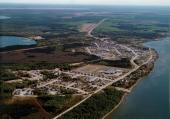
Northern village, pop 2,136, located in NW Saskatchewan near the Saskatchewan-Alberta border, NW of Buffalo Narrows and just S of Clearwater River Provincial Park on Hwy 155. The community sits on the east side of Lac La Loche and immediately to the north is the main reserve of the Clearwater River Dene Nation. Although aboriginal peoples had traversed the area for generations, the origins of today’s community began with the arrival of fur traders and, later, missionaries. Lac La Loche is one of the headwaters of the Churchill River and in 1778 Indian guides led Peter Pond over Portage La Loche, or Methy Portage, to the Clearwater River. The 20-km portage bridged the height of land between the Hudson Bay and Arctic Ocean drainage basins and opened up the vast Athabasca region. La loche is French for the burbot, a variety of freshwater cod, and the word “methy” is derived from the Cree term for the same fish. Rival fur trading posts operated on Lac La Loche over the decades following Pond’s “discovery” and from the mid-1800s a community began to develop on the west side of the lake. About the same time Catholic missionaries from Ile-à-la-Crosse began working in the area. In 1895 a mission was established at the site of the present community. In 1943, the Grey Nuns arrived at La Loche bringing Western education and nursing to the community. In 1962-63 a road from the south was built to the village, but it was not until 1974 that dial telephone services were available. In 1976, the community received television. Sewer, water, and electrical systems were developed in the 1970s and, in 1983, La Loche was incorporated as a northern village. The population is largely Métis and non-treaty Dene and is very young compared to the rest of the province. Over half of the population are children. Since the demise of the fur trade, La Loche has struggled with high unemployment (close to 50% today). La Loche Community School has an enrolment of close to 1,000; with 50 full-time teachers and a support staff of an additional 50 people, it is the largest employer in the community.
David McLennan